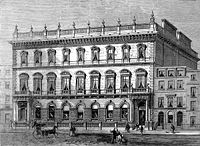
Junior Carlton Club
Encyclopedia

London
London is the capital city of :England and the :United Kingdom, the largest metropolitan area in the United Kingdom, and the largest urban zone in the European Union by most measures. Located on the River Thames, London has been a major settlement for two millennia, its history going back to its...
gentlemen's club
Gentlemen's club
A gentlemen's club is a members-only private club of a type originally set up by and for British upper class men in the eighteenth century, and popularised by English upper-middle class men and women in the late nineteenth century. Today, some are more open about the gender and social status of...
, now dissolved, which was established in 1866 and was disbanded in 1977.
History
Anticipating the forthcoming Second Reform Act under Benjamin Disraeli, numerous prospective electors decided to form a club closely aligned to the Conservative partyConservative Party (UK)
The Conservative Party, formally the Conservative and Unionist Party, is a centre-right political party in the United Kingdom that adheres to the philosophies of conservatism and British unionism. It is the largest political party in the UK, and is currently the largest single party in the House...
. Adopting the model of numerous other clubs of the day, i.e. the Junior Athenaeum
Junior Athenaeum
The Junior Athenaeum Club was a now defunct gentlemen's club formerly in Piccadilly, London. It was founded in 1864 and occupied the house once inhabited by the Duke of Newcastle, and which had been built at great cost by his father-in-law, the late Henry Thomas Hope. Originally called 'Hope...
, the Junior Oxford and Cambridge Club, etc, the club styled itself the Junior Carlton after the Carlton Club
Carlton Club
The Carlton Club is a gentlemen's club in London which describes itself as the "oldest, most elite, and most important of all Conservative clubs." Membership of the club is by nomination and election only.-History:...
, which had a fixed number of members, and a lengthy waiting list, and so was therefore likely to remain out of the reach of these soon-to-be-enfranchised/newly-enfranchised electors.
According to Anthony Lejeune, the Junior Carlton was the only one of the many clubs with the 'Junior' prefix to achieve anything of the prestige of the longer-standing, more established clubs which they sought to emulate.
Club building
From 1869, the club was housed in sumptuous premises at 30 Pall MallPall Mall, London
Pall Mall is a street in the City of Westminster, London, and parallel to The Mall, from St. James's Street across Waterloo Place to the Haymarket; while Pall Mall East continues into Trafalgar Square. The street is a major thoroughfare in the St James's area of London, and a section of the...
designed by David Brandon
David Brandon
David A. Brandon is the director of intercollegiate athletics for the University of Michigan. He was formerly chairman of the board, chief executive officer, and manager of Domino's Pizza. He is also a former regent of the University of Michigan. Brandon took over Domino's in March 1999 when...
, which it occupied well into the twentieth century. The club building was built by Lucas Brothers
Lucas Brothers, Builders
Lucas Brothers was a leading British building business based in London.-Early history:The business was founded by Charles Thomas Lucas and Thomas Lucas . They were the sons of James Lucas , a builder, of St Pancras, London...
.
Unfortunately, in the post-World War II era, it was to be the victim of an unfortunate planning decision by its ruling committee. The 'senior' Carlton Club building at 94 Pall Mall had suffered a direct hit during the Blitz
The Blitz
The Blitz was the sustained strategic bombing of Britain by Nazi Germany between 7 September 1940 and 10 May 1941, during the Second World War. The city of London was bombed by the Luftwaffe for 76 consecutive nights and many towns and cities across the country followed...
, and the site had proved difficult to sell for redevelopment. In 1963, the Junior Carlton's committee decided to proceed with the sale of the existing Junior Carlton building, and use part of the proceeds to purchase the site of the old Carlton. They opted to construct a bold new building described at the time as "the club of the future" . The resulting concrete block, luridly decorated to 1960s architectural tastes, opened in 1968 and is still in use today as an office building. It proved so abhorrent to the membership that they fled in droves, mainly joining the Carlton.
By 1977, the club was wound down and its few remaining members formally merged with the Carlton.

